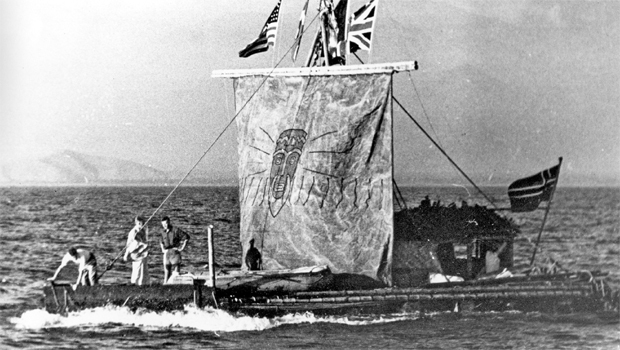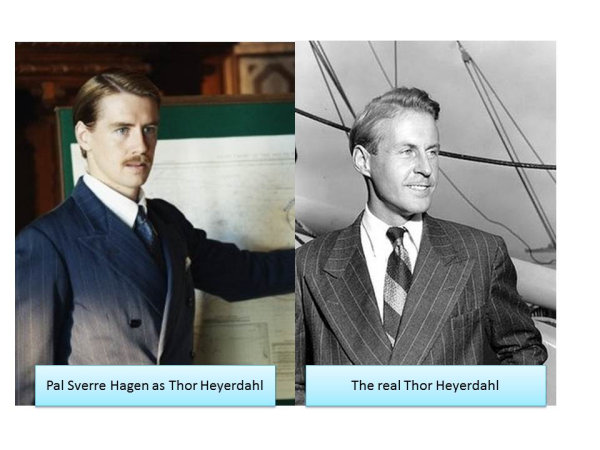
When I am grading exams, I find that my students occasionally (and unintentionally) make me laugh out loud. This semester, in answer to “Who was Thor Heyerdahl?” one student wrote so delightfully to the point that it made me guffaw: “A guy on a raft.”
I awarded her the full two points, because what was Thor Heyerdahl if he was not, indeed, a guy on a raft? Yet this summer’s sleeper movie, Kon-Tiki, shows that he was far, far more than that.
The Norwegian production simultaneously filmed English and Norwegian versions, so although I caught the English version, the film is still “foreign” in that it has had a limited U.S. distribution. In Manhattan it is being shown only at The Paris and a tiny theater in Forest Hills, Queens.
That is a terrible shame. Kon-Tiki takes us back not only to Heyerdahl”s epic adventure, but to the days of exciting, feel-good films with a dashing hero and a real message (in this case, “Have faith,,” line that Thor says often to his ever-skeptical and ever-sunburned, crew).
Surprisingly, it has taken more than sixty years for a dramatization of the Kon-Tiki expedition to appear. For those unfamiliar with the story, Heyerdahl was a young Norwegian anthropologist who, in 1947, defied mockery by his professional peers to support his theory that Polynesia was initially inhabited by the Pre-Columbian peoples of South America, and not (as was believed) by people indigenous to Asia. One reason Heyerdahl's theory was instantly dismissed was because it seemed impossible for Pre-Columbians to have made a voyage of 5,000 miles in balsa-wood rafts. Heyerdahl, only 33 years old, decided to prove the world wrong by voyaging on such a craft to Polynesia himself. His raft, The Kon-Tiki, was named after the Maori god Tiki, said to be the First Man on Earth.

Assembling a motley crew of half a dozen friends (one of whom could operate a radio, yet one of whom was a refrigerator salesman who had never been to sea), the Kon-Tiki set sail from Peru with no means of navigation in order to prove Heyerdahl’s theory that Pre-Columbians simply floated to Polynesia upon the Western currents.
That it was a dangerous mission is an understatement--especially in the case of Heyerdahl himself, who had never learned to swim! However, he had the foresight to film the epic voyage. The resulting movie, The Kon-Tiki Expedition, won him an Oscar for Best Documentary in 1951.
After 101 treacherous days floating around the South Pacific, the Kon-Tiki and its crew crashed into a reef half a mile from the beaches of Raroia in the Polynesian island chain of Tuamotu, suggesting that Heyerdahl’s theory was possibly correct.
The handsome Heyerdahl instantly became world famous, and his account of the voyage, The Kon-Tiki: Across The Pacific By Raft, was translated into 70 languages and sold 50 million copies. The adventure seized the imagination of a world still experiencing postwar gloom.
Further, the adventure also helped launch the “Tiki Craze” of the 1950s, an obsession with anything Polynesian, which saw the opening of bars and restaurants like Trader Vic’s and the popularity of the Mai Kai, a drink that promised a “taste of paradise” and “native excitement” to the uptight Cold War crowd.

Directed by Joachim Rønning and Espen Sandberg, and starring Pal Sverre Hagenas as Thor Heyerdahl, this year’s Kon-Tiki came as a surprise. Cynical as always, I approached the film with trepidation. I had seen the explorer’s original documentary, and wondered if there was any point to making a dramatization of what was already a thrilling documentary. There was!
The original was, of course, not only filmed by amateurs, but in the distanced formal style of 1940s documentaries. Although the book illuminated the emotional dynamics of the crew on the voyage, that element was absent from the original film. The new film corrects that shortcoming, and provides a portrait of Heyerdahl”s fanaticism as well as the genuine fear that the intrepid Norwegian’s faced for every one of their 5,000 nautical miles. Yet it is Pal Sverre Hagen who carries the movie. His performance as a young man out to vindicate himself (always retaining his Nordic politeness) make for a hero worth rooting for.

Because it was beautifully shot and necessarily included cgi, (the real Kon-Tiki was relentlessly besieged by sharks, and was threatened by whales, and as sharks and whales are not cooperative actors, cgi was needed!), the new film about Kon Tiki has been compared (mostly favorably) to last year’s Life of Pi. Yet those comparisons miss the point; true, both films centered on protagonists on rafts. Yet Pi was a fantasy. Kon-Tiki was real.

And that is what ultimately made the movie so unbelievably moving; this was a real story about real heroes who did something epic and amazing (and not a little nuts), and truly deserved the celebrity thrust upon them.
I went to see Kon-Tiki with my father (David Wolfe, “The Fashion Dad”), and over a pre-movie lunch, he taught me a new word; “fauxmous,” which refers to people who are famous for doing absolutely nothing of note (Kardashians, the Housewives, et al). So it was with mixed emotions that I left Kon-Tiki; in a world that is glued to watching television about fauxmous people shopping in Beverly Hills or getting their nails done, it was wonderful to be reminded that there was once a time when people became famous for doing something great.
David Wolfe and I both live in Sea Cliff, a village on the Long Island Sound. “I want to build a raft and see if we can float to Port Washington!” The Fashion Dad joked as we drove home from Queens. Yet behind his humor lay a genuine desire to “do something great” that this movie inspired.
Although hard to catch at the cinema, I was delighted to see that Kon-Tiki (nominated for Best Foreign Film in this year’s Academy Awards) is already available on Blu-Ray DVD. I urge you all to see it. Today having a dream (let alone following a dream) is often derided, so it was truly uplifting to see a movie that, instead of cynically applauding the violence of some snarky anti-hero or comic book character, celebrates a true and brave accomplishment.
Because, at the end of the day, aren’t we all (metaphorically) “a guy on a raft”?
Amanda Hallay is a full-time faculty member at LIM College, where she teaches courses on the relationship between fashion and popular culture past and present. Her course Who Wore What When includes discussion of indigenous art and dress of the South Pacific.
Topics: tiki, Kon Tiki, Heyerdahl, sea adventure, Polynesian craze